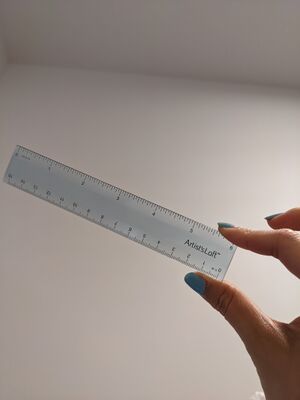Course:PHYS341/2022/Project17
Ruler (Musical Instrument)

Rulers as Instruments
On the internet, song covers played with rulers have trended from time-to-time and over the years, ruler-playing has eventually established itself as a niche skill amongst music enthusiasts. Although often regarded as a "joke instrument", some rulers do possess surprising musical potential despite its original design intentions. The ruler when played can be characterized by its slightly comical and buzzy sound, somewhat resembling a springy door stopper.
How the Ruler Works as an Instrument
How It's Played
The concept is very simple, a certain length of one end of the ruler hangs off a ledge (preferably a table or countertop that is empty underneath or hollow) and the player holds down the other end firmly. The free hand plucks the suspended end of the ruler to produce sound. The pitch of the sound can be alternated by hanging more or less of the ruler off of the ledge. As rulers come with hatch marks, it is possible to align the ledge of the surface with the marks for more accuracy when playing.
Instrumental Comparisons
The ruler would most likely be best categorized as an idiophone, which are "instruments that create sound through vibrating themselves."[1] I came to this reasoning after comparing the method of playing the ruler to the mbira, which is played by plucking the parts or the tongues[2] with one's fingers to produce sound. The main difference between the mbira and the ruler would be material and the resonator, which in the case of the ruler does not exist and relies solely on the surface chosen.


Depending on the surface on which the ruler is played and the material of the ruler, the ruler can exhibit very different tones. Due to my acquired metal ruler being one with cork attached to one side (comprised of multiple materials), I will focus mainly on the plastic ruler for more consistency and better results.
Problems With Instrumental Use
As seen in Fig. 1., the frequency comes to around 90.9Hz, and the frequency of Fig. 2. is about 55.5Hz. Although both played at 7.5cm, the two sound drastically different, going from a near F#2/Gb2 down to almost A1 in notes. The sound played on the wooden desk to me sounds more clear and cleaner when played, while the countertop seems a little deeper and muted. I contribute this to the same way as string instruments depend greatly on not just the strings but the body and cavity of the instrument when producing sound, the "body" of the ruler as mentioned earlier is non-existent, when compared to similar instruments such as the mbira. This results in a certain inconsistency and lack of a signature "ruler" type of sound, and instead it can be assumed that a ruler can produce sound and make music, but the notes it will produce at each hatch mark will vary and heavily depends on the surface it is hanging off of.


In this case, looking at the spectrum graph may give us more insight regarding how the sound changes when using different surfaces.
The distribution of the same length played on the two different surfaces differ greatly, as on the wooden desk the fundamental lies much higher than on the kitchen countertop. this likely contributes to the different sound profiles and notes observed earlier.
How I Would Play the Ruler
To conclude the previous observations, the ruler playing experience will rely heavily on the individual's environment. Because of this, I decided to test out a few notes on my wooden desk.
I tried out some different lengths on my plastic ruler, and sought to find some consistent and predictable changes in regards to length.
At 8 centimeters, the frequency measured out to be at around 76.9Hz; 9 centimeters was at 111.1Hz; 10 centimeters was at 142.9Hz. This calculates for each centimeter to add around 33Hz.
The reason why I did not include other measurements was due to the fact that they sound quality and graph began to look a lot messier and inconsistent, and I realized that perhaps I needed a longer plastic ruler, preferably 30 centimeters, which Michael's did not offer in flexible material at a reasonable price.
Conclusion
A regular 15 centimeter ruler can barely become an instrument, at least not one that is accurate and consistent. However, if based on one's judgement of musical perception, it may be possible to simulate music in a convincing manner. Alternatively, with a custom made "ruler" and designated surface to play on, an actual instrument can indeed be made out of this concept.
With this and my poor sense of musical judgement, I present to you my own rendition of Twinkle Twinkle Little Star on the ruler.